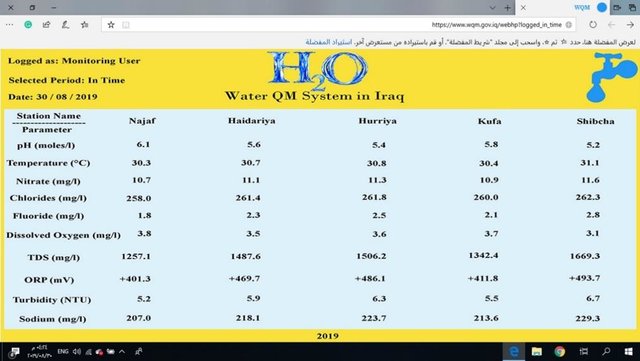جامعة الكفيل

The degrading drinking-water quality in Najaf, Iraq, requires immediate attention. This paper present an electronic water-monitoring system capable of facilitating proactive response to curb unsafe water supply in Najaf. The proposed system is intended to replace the conventional method, which is time-consuming and fails at real-time data generation. The proposed system is affordable and based on a wireless sensor network (WSN) and internet of things (IoT) to perform real-time monitoring and issue timely warning SMSs and e-mails. In this study statistical analysis was performed on data collected from five different water stations within Najaf. To demonstrate implementation of the proposed system, a user-specific website that highlights the water-purification process has been developed. The system affords remote-and smart-monitoring capabilities to determine water pH level; temperature; nitrate, chloride, and dissolved oxygen concentration; turbidity; oxidation-reduction potential (ORP); conductivity or total dissolved solids (TDS) and sodium content. Findings of this study indicate that drinking-water quality in Najaf is poor, and that the current water-purification system is unable to maintain prescribed water-quality standards. Results from five stations demonstrate that measured levels of water-quality parameters are well below those prescribed by the World Health Organization. Use of the proposed water-quality monitoring system serves to enhance drinking-water quality significantly.

The degrading drinking-water quality in Najaf, Iraq, requires immediate attention. This paper present an electronic water-monitoring system capable of facilitating proactive response to curb unsafe water supply in Najaf. The proposed system is intended to replace the conventional method, which is time-consuming and fails at real-time data generation. The proposed system is affordable and based on a wireless sensor network (WSN) and internet of things (IoT) to perform real-time monitoring and issue timely warning SMSs and e-mails. In this study statistical analysis was performed on data collected from five different water stations within Najaf. To demonstrate implementation of the proposed system, a user-specific website that highlights the water-purification process has been developed. The system affords remote-and smart-monitoring capabilities to determine water pH level; temperature; nitrate, chloride, and dissolved oxygen concentration; turbidity; oxidation-reduction potential (ORP); conductivity or total dissolved solids (TDS) and sodium content. Findings of this study indicate that drinking-water quality in Najaf is poor, and that the current water-purification system is unable to maintain prescribed water-quality standards. Results from five stations demonstrate that measured levels of water-quality parameters are well below those prescribed by the World Health Organization. Use of the proposed water-quality monitoring system serves to enhance drinking-water quality significantly.